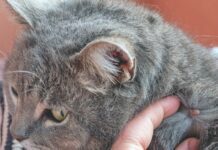A recent study looked at three feline hormones and gut microbiomes to see if there was a correlation with which cats got along best in a group. With the exception of lions, most cat species are solitary even if they live in shelter settings and multi-cat households.
In this study, five spayed female and 10 neutered male cats in a shelter “volunteered” for the trial. The researchers examined three hormones, cortisol, testosterone, and oxytocin.
As expected, cats with higher levels of testosterone and cortisol were less likely to establish bonds and be happy in a group. Cats with higher testosterone also showed a greater tendency to escape.
The surprising finding was with oxytocin levels. This hormone is associated with several maternal behaviors, and the scientists felt higher levels of oxytocin would correlate with more acceptance of group living. Unlike other species, cats with higher oxytocin levels were less likely to tolerate other feline companions. The study also found that gut microbiomes tended to be similar in cats that hung out together, probably the effect of interactions.
More work needs to be done on this finding, but the oxytocin results suggest that, once again, cats are somewhat unique in their physiology.




